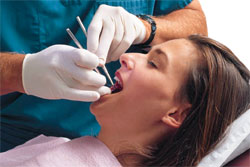What is the thermocatalytic technique?
- How is the thermocatalytic technique done?
- Side effects of the thermocatalytic technique
What is the thermocatalytic technique?
The thermocatalytic technique is applied to teeth that have had root canal treatments. It involves bleaching the tooth from the inside of the tooth. It is similar to the walking bleach technique, except that it uses a thermal light to activate the bleaching agent.
This technique has been proposed for many years as the best technique to bleach non-vital teeth (those teeth which do not have a blood supply) because of the strong interaction between hydrogen peroxide and heat.
How is the thermocatalytic technique done?
This is the general procedure for the thermocatalytic technique:
- Vaseline is applied on the lips and a rubber dam is applied on the tooth being whitened.
- A hole is made into the space inside your tooth.
- A material is placed over the top of the root canal filling to protect the tooth from the bleaching agent.
- The bleaching agent is then placed inside the tooth.
- At this stage, heat is applied to your tooth to help the bleach inside your tooth.
- A temporary filling is placed into the tooth to protect the inside of the tooth, and to give time for the bleach to work.
- After one week, you are asked to come in once again. At this appointment, decide if there is a need to re-do the bleaching protocol. If everyone is happy with the result, it is advisable to remove the bleaching mixture, place a temporary filling, and place a permanent filling after 3 weeks. The delay in placing a permanent filling helps to maximise the bond strength of the filling.
Side effects of the thermocatalytic technique
One of the most important effects is the changes in enamel and dentin. This can affect how long fillings last on the tooth, and also the strength of the enamel.
There can also be problems such as the tooth becoming pink as a result of a problem known as cervical invasive resorption. We do not know why this occurs in people. It can be fixed in the early stages by a dentist; however, extreme cases may result in the loss of your tooth if you get this rare condition.
Kindly written by Dr Akhil Chandra BDSc (Hons UWA)
Dentist, Whitfords Dental Centre, and Editorial Advisory Board Member of the Virtual Dental Centre
More information
 |
For more information on various bleaching techniques for teeth, including home bleaching, assisted bleaching, power bleaching, the thermocatalytic technique and the walking bleach technique, see Teeth Whitening. |
References
- Plotino G, Buono L, Grande NM, Pameijer CH, Somma F. Nonvital tooth bleaching: a review of the literature and clinical procedures. J Endod. 2008 Apr;34(4):394-407.
- Abbott, P.V. Endodontics and dental traumatology: An overview of modern endodontics. Perth: International Federation of Endodontic Associations 1999.
- Attin T, Hartmann O, Hilgers RD, Hellwig E. Fluoride retention of incipient enamel lesions after treatment with a calcium fluoride varnish in vivo. Arch Oral Biol. 1995 Mar;40(3):169-74.
- Heithersay GS. Clinical, radiologic, and histopathologic features of invasive cervical resorption. Quintessence Int. 1999 Jan;30(1):27-37.
All content and media on the HealthEngine Blog is created and published online for informational purposes only. It is not intended to be a substitute for professional medical advice and should not be relied on as health or personal advice. Always seek the guidance of your doctor or other qualified health professional with any questions you may have regarding your health or a medical condition. Never disregard the advice of a medical professional, or delay in seeking it because of something you have read on this Website. If you think you may have a medical emergency, call your doctor, go to the nearest hospital emergency department, or call the emergency services immediately.








